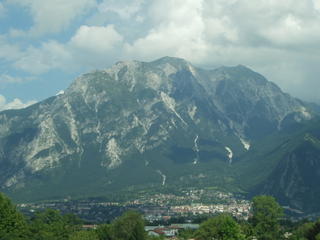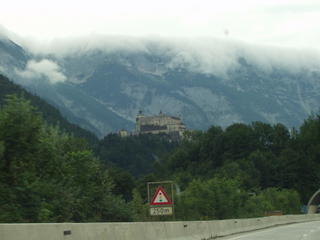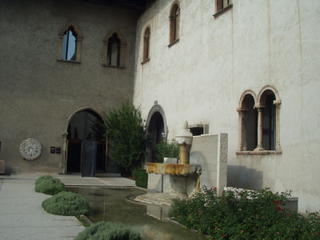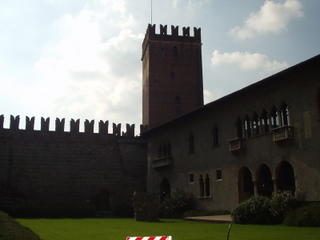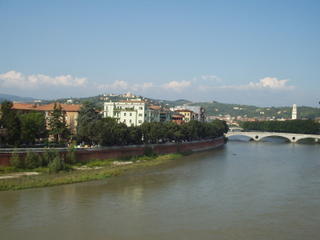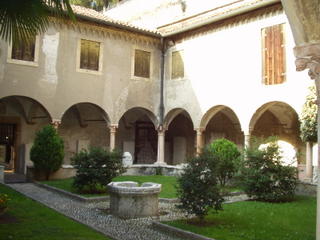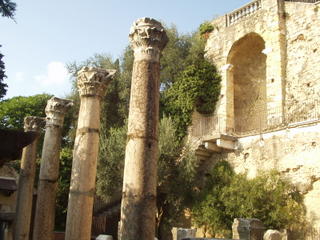Oktoberfest Parade
This morning R & I went to the Oktoberfest Parade with a few other friends. The parade started just a few blocks from our apartment! Unfortunately it was a pretty cold day :-(. I also forgot to bring my camera, so I will post the pictures after I get a copy of it from my friends.If you have not heard already, Oktoberfest (also referred to as "die Wiesn" basically is a huge beer drinking party held here in Munich every year. It ends on the first weekend of October. A brief historical background: the first Oktoberfest was held in the year 1810 in honor of the Bavarian Crown Prince Ludwig’s marriage to Princess Therese von Sachsen-Hildburghausen. The festivities began on October 12, 1810 and ended on October 17th with a horse race. Now, if you are wondering why it is called the Oktoberfest if it happens in September - This why...In the following years after 1810, the celebrations were repeated and, later, the festival was prolonged and moved forward into September. By moving the festivities up, it allowed for better weather conditions. Because the September nights were warmer, the visitors were able to enjoy the gardens outside the tents. Historically, the last Oktoberfest weekend was in October and this tradition continues into present times. Coming back to the parade happens every year at the 1st Wiesn sunday. This is the official prelude to the opening of the Oktoberfest and involves about 1,000 participants. The parade is headed by the Münchner Kindl--the little Munich city's coat of arms. The mayor arrives in a festive coach followed by civic dignitaries and horse-drawn brewer's carts (there are six big breweries in Munich) decorated with flowers. This colorful ceremony with elaborate floats, beer bands and men, women and children wearing traditional costumes (lederhosen and dirndls) dates back to 1887. I was also pleasantly surprised to learn that Austria & Switzerland participate in the parade as well. Lowenbrau
Lowenbrau Spatenbrau
Spatenbrau Hacker-Pschorr Brau
Hacker-Pschorr Brau Paulaner
Paulaner Hofbrau
Hofbrau AugustinerbrauYou can read more about the big breweries here and about Oktoberfest in general here.Lowenbrau
AugustinerbrauYou can read more about the big breweries here and about Oktoberfest in general here.Lowenbrau
Verona Part 1
 Verona lies right smack between the two more famous cities of Italy - Milan & Venice. Verona's claim to fame is through the city's well known lovers Romeo & Juliet immortalized by Shakespeare. Though there are markers indicating the houses of Romeo & Juliet, historians have not been able to say for sure if the lovers did ever really exist outside of the famous author's imagination. Infact, I read that it is widely believed that Shakespeare never even set foot to Italy!
Verona lies right smack between the two more famous cities of Italy - Milan & Venice. Verona's claim to fame is through the city's well known lovers Romeo & Juliet immortalized by Shakespeare. Though there are markers indicating the houses of Romeo & Juliet, historians have not been able to say for sure if the lovers did ever really exist outside of the famous author's imagination. Infact, I read that it is widely believed that Shakespeare never even set foot to Italy!
Anyway, coming to my story - R had a business meeting near Venice on the 12th and so we decided it might be a good idea to spend the weekend in Italy. Taking into account that it was a last minute plan and our not so vast budget for the trip we decided that Verona would be a better choice. It was a really nice & relaxing weekend in Verona & Lake Garda.
Also, thankfully an Italian girl in my German class who happened to be from Verona, gave me a very comprehensive list of the "Must See" places in the area. First on the list was the "Arena", a Roman Colliseum that is used to date as a concert hall. Infact the following there was going to be a pop concert. Built in AD 100, the elliptical colliseum in Verona is considered to be one of the best preserved Roman amphitheater in the world and the best known in Italy after Rome's and has a seating capacity of over 22,000! The outer wall of the arena was destroyed by an earthquake in the 12th century. The arena sits by the well known Piazza Bra (Piazza basically means "Public Square").  The arena - rennovations being done on the exterior
The arena - rennovations being done on the exterior
 Inside the arena, stage set for a pop concert - what acontrast to the gladiatorial events of the Roman days
Inside the arena, stage set for a pop concert - what acontrast to the gladiatorial events of the Roman days The only peice of the outer wall still in existence after the earthquake
The only peice of the outer wall still in existence after the earthquake A close-up of the outer wall
A close-up of the outer wall The pathway before entering the arena - imagine gladiators lined up here ready to enter
The pathway before entering the arena - imagine gladiators lined up here ready to enter Exit stairways of the areana used in the Roman days, now just a rubble
Exit stairways of the areana used in the Roman days, now just a rubble 'Palazzo Barbieri', the Town Hall finished in 1883Our next stop was Piazza Della Erbe (ofcourse we got sidetracked on Via Mazzini looking at all the gorgeous designer stores on the way, Dolce & Gabana, Gucci, Armani - to name a few.) Piazza Erbe is a bustling marketplace and sits on the former site of the Roman Forum where chariot races once took place. It is also quite close to some of the attractions of the town namely "Casa di Giulietta" or Julliet' house and the Piazza dei Signori containing the Arche Scaligeri (Scaligeri tombs) and the Lamberti tower.
'Palazzo Barbieri', the Town Hall finished in 1883Our next stop was Piazza Della Erbe (ofcourse we got sidetracked on Via Mazzini looking at all the gorgeous designer stores on the way, Dolce & Gabana, Gucci, Armani - to name a few.) Piazza Erbe is a bustling marketplace and sits on the former site of the Roman Forum where chariot races once took place. It is also quite close to some of the attractions of the town namely "Casa di Giulietta" or Julliet' house and the Piazza dei Signori containing the Arche Scaligeri (Scaligeri tombs) and the Lamberti tower.  Piazza Erbe
Piazza Erbe The 'Palazzo Mafei' is a 1668 work. On the top of it you can see the six pagan divinities sculptures (Jupiter, Mercury, Venus, Apollo, Hercules and Minerva). The winged lion is a symbol of the Veneto rulers of Venice. Though an independent state, Verona eventually suurendered to the rulers of Venice.
The 'Palazzo Mafei' is a 1668 work. On the top of it you can see the six pagan divinities sculptures (Jupiter, Mercury, Venus, Apollo, Hercules and Minerva). The winged lion is a symbol of the Veneto rulers of Venice. Though an independent state, Verona eventually suurendered to the rulers of Venice. Arche Scaligeri - The tombs of the Scaligeri clan
Arche Scaligeri - The tombs of the Scaligeri clan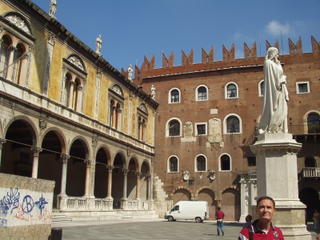 Piazza dei Signori -You can see here Dante’s Sculpture and, behind, the ‘Loggia del Consiglio’ building.
Piazza dei Signori -You can see here Dante’s Sculpture and, behind, the ‘Loggia del Consiglio’ building. Juliet's house - the balcony from which she is said to have first laid her eyes on Romeo.
Juliet's house - the balcony from which she is said to have first laid her eyes on Romeo.
























